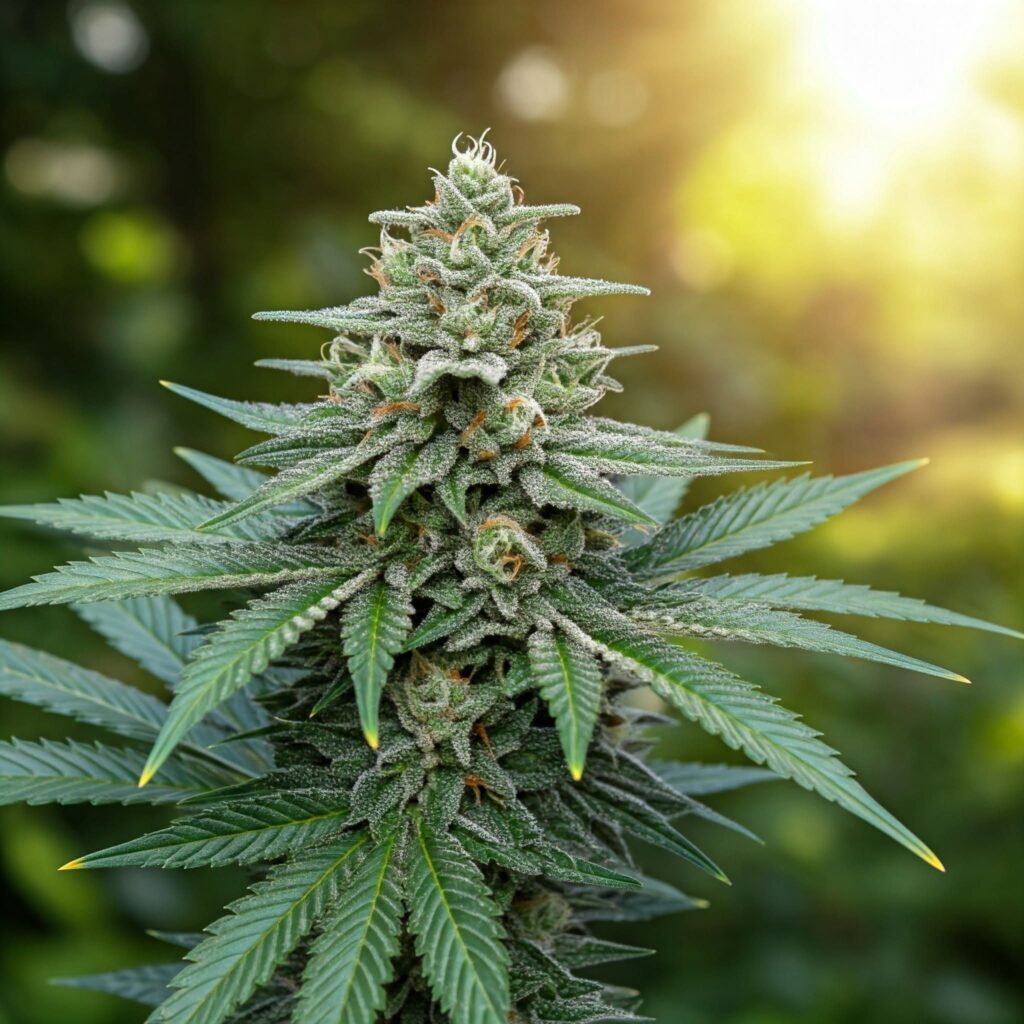Caryophyllene: The Spicy, Sensory Star of the Hemp World
When it comes to terpenes, caryophyllene is in a league of its own. Known for its bold, peppery aroma and intriguing interactions with cannabinoids, this terpene doesn’t just contribute to the smell of some your favorite hemp strains—it’s an active player in the sensory experience. In this guide, we’re diving into what makes caryophyllene so special, from the science behind its unique properties to how it amplifies the characteristics of different strains. So grab your favorite mug of herbal tea (or whatever else you had in mind, 😉 ) and let’s explore this spicy superstar of the hemp world.
What is Caryophyllene? A Terpene with a Kick
If caryophyllene had a personality, it would be the bold friend who always spices up the room. This unique terpene doesn’t just lend its peppery, spicy aroma to hemp; it’s a jovial friend across the plant kingdom. Found in some of your pantry staples and favorite drinks, it’s what gives black pepper its sharpness, cloves their warmth, and hops their bitter edge. But what really sets caryophyllene apart is its ability to interact directly with the body’s endocannabinoid system—a rare trait among terpenes.
You’ll find caryophyllene in more places than you’d expect, including:
- Black Pepper: Its most iconic source, delivering that unmistakable sharp, spicy punch.
- Cloves: A key player in clove’s warm and slightly sweet aroma.
- Hops: Adding a bitter kick to your favorite craft beers.
- Cinnamon: Contributing to its complex, spicy-sweet profile.
- Basil: Especially in varieties like Thai basil, with its peppery edge.
- Oregano: Boosting the earthy, aromatic notes in your favorite Italian dishes.
- Rosemary: Enhancing its herbaceous and slightly piney scent.
This versatility has made caryophyllene a favorite not only among hemp enthusiasts but also in culinary and wellness circles. Whether it’s amplifying the aroma of a hemp strain or elevating the taste of a dish, this terpene is proof that the smallest compounds can have the biggest impact.

The Science of Caryophyllene: The Spicy Molecule in Action
So, what makes caryophyllene such a standout in the terpene world? It all comes down to its structure and how it plays well with others—especially cannabinoids.
Caryophyllene: A Sesquiterpene with a Twist
Caryophyllene belongs to the sesquiterpene family, a group of terpenes with more complex molecular structures compared to lighter monoterpenes like limonene or pinene. This complexity isn’t just for show—it gives caryophyllene its stability and contributes to its rich, peppery aroma. But the real twist lies in its ability to act as a cannabinoid itself.
That’s right: caryophyllene is unique among terpenes because it binds directly to CB2 receptors in the body. These receptors are part of the endocannabinoid system (ECS), which regulates functions like mood, immunity, and inflammation. While CB1 receptors (mostly found in the brain) are responsible for the psychoactive effects of THC, CB2 receptors are more involved in maintaining balance in the body, particularly outside the central nervous system.
How Does This Work?
Think of CB2 receptors as locks, and compounds like caryophyllene and cannabinoids as keys. When caryophyllene binds to these receptors, it helps “unlock” responses in the ECS. While it doesn’t create a “high” like THC, these cannabinoid interaction may support the entourage effect—a theory suggesting that terpenes and cannabinoids work synergistically to enhance the overall experience of hemp.
In fact, here’s what sets caryophyllene apart:
- A Functional Cannabinoid: Caryophyllene is often called a “dietary cannabinoid” because it appears in foods like black pepper and cloves, meaning you might already be interacting with your ECS at dinner.
- Non-Psychoactive: Unlike THC, its effects are more about balance and subtle enhancement.
- Entourage Effect Superstar: Caryophyllene may amplify the properties of cannabinoids like CBD and THC, contributing to a more nuanced hemp experience.
What Does This Mean for Hemp Strains?
The presence of caryophyllene in a strain doesn’t just affect its aroma; it plays a role in defining the character of the experience. Strains rich in caryophyllene often have earthy, spicy profiles and are prized for their well-rounded effects. It’s no surprise that cultivators and enthusiasts often seek out this “spicy terpene” when exploring strain profiles.
Exploring Studies Involving Caryophyllene
Caryophyllene has garnered significant interest in scientific studies due to its unique interactions within biological systems. This terpene may play a supportive role in various processes related to overall wellbeing. Below are summaries of several key studies with links to the original research for further exploration.
1. Interaction with CB2 Receptors
Caryophyllene is distinct among terpenes for its ability to bind directly to CB2 receptors in the endocannabinoid system, which are primarily associated with immune responses and maintaining homeostasis. A study published in Frontiers in Pharmacology explored this unique interaction and its implications for cellular signaling, particularly in the context of inflammation in alveolar cells. The study explored how caryophyllene may modulate immune responses to encourage cellular balance in respiratory tissues. Access the study here.
2. Influence on Inflammatory Pathways
A review in Nutrients investigated caryophyllene’s interactions with cellular pathways linked to inflammation. These pathways are integral to maintaining the health of metabolic, immune, and nervous systems. The study highlighted caryophyllene’s ability to interact with specific receptors and mediators of oxidative stress like TNF-α and IL-6, which are relevant to the body’s natural defense mechanisms. Read the review here.
3. Synergy with Other Compounds
Research in Cannabis and Cannabinoid Research examined how caryophyllene interacts synergistically with cannabinoids such as THC and CBD. This synergy may influence processes within the endocannabinoid system that help support the nervous system, immune system, and general equilibrium in the body. For more details, see the research paper here.
4. Cellular Health and Recovery
In a study published in Phytomedicine, caryophyllene was investigated for its potential role in cellular repair and recovery processes, which are essential for skin health and tissue recovery. The research highlighted how this terpene may support mechanisms related to cell proliferation and protection. Read more here.
Caryophyllene’s Signature Aroma: Bold, Complex, and Inviting
Picture yourself in an aromatic haven, like a bustling spice market or a warm kitchen, where freshly cracked black pepper, cloves, and a touch of earthy woodiness mingle in the air. Caryophyllene is the star ingredient of this sensory symphony, known for its robust and spicy profile. This terpene doesn’t just stand out—it weaves a narrative of boldness and complexity that enhances the overall experience of hemp and other botanicals.
Unlike lighter or sweeter terpenes, caryophyllene’s grounding aroma brings depth and character. Think of it as the bass note in a melody—it supports and enriches, creating balance while allowing other aromatic compounds to shine. Whether found in the zest of a peppercorn or the smooth warmth of cinnamon bark, caryophyllene’s versatility adds a unique dimension to the sensory journey.
When combined with cannabinoids, its presence feels like the perfectly measured pinch of spice in a gourmet dish. It enhances without overpowering, creating a fuller, more layered experience that resonates both aromatically and aesthetically.

Caryophyllene’s Synergy with Cannabinoids
Caryophyllene is more than just an aromatic enhancer—it also contributes to the intricate interplay of compounds in hemp. This terpene works alongside cannabinoids like THC and CBD to influence the overall experience of a strain, adding depth and subtlety to its effects.
When paired with THC, caryophyllene can contribute to an experience often described as warming and grounding, enhancing the physical relaxation or calmness THC may promote. Some users report that strains rich in caryophyllene feel slightly invigorating or more robust in their sensory effects, adding a layer of complexity to the strain’s character.
With CBD, caryophyllene may enhance the soothing qualities of the cannabinoid, creating a balanced and mellowing effect. Its grounding nature is sometimes described as giving a sense of composure or centeredness, which complements CBD’s natural profile. This unique synergy highlights caryophyllene’s role as a terpene that helps round out the sensory experience, whether calming, invigorating, or a mix of both.
As part of the entourage effect, caryophyllene’s contributions go beyond its aroma to influence the nuanced characteristics of hemp strains, creating a distinctive sensory journey tailored by its chemistry.
Caryophyllene’s Sensory Journey
Caryophyllene’s presence in hemp has often been likened to experiences that ground and comfort, painting a sensory landscape that is both vivid and familiar. Imagine the reassuring warmth of a crackling fire on a chilly evening or the soothing calm of savoring a spiced chai tea. These metaphors encapsulate the essence of caryophyllene’s contribution—a steady, balancing influence that enhances the overall sensory experience without overwhelming it.
Caryophyllene’s spicy, peppery notes add a tactile quality, similar to the invigorating yet calming sensation of walking through a sunlit forest after rain, where the earthy aroma of damp soil and leaves fosters a sense of connection to the natural world.
This grounding influence doesn’t rush or overpower but instead harmonizes with other terpenes and cannabinoids, helping to shape a layered experience. It evokes a sense of being present and centered, much like the steady rhythm of waves on a tranquil shore.
Caryophyllene’s Role Across Hemp Strains
Caryophyllene’s influence on hemp strains is as dynamic as the terpene itself. Found in a variety of cultivars, it often signals a strain with bold, peppery, and earthy characteristics. Its presence isn’t just about aroma; it also shapes the sensory experience, contributing to a strain’s overall depth and balance.
For instance, strains like GSC (Girl Scout Cookies) and Sour Diesel are celebrated for their rich terpene profiles, where caryophyllene provides a grounding undertone that complements the more vibrant effects of other terpenes. In hybrids, it often acts as a stabilizing influence, tempering the energetic effects of limonene or pinene with a soothing, steady presence.
Caryophyllene also contributes to the character of Indica-leaning strains such as Bubba Kush, where its earthy and spicy profile enhances the strain’s reputation for cozy relaxation. On the other end of the spectrum, in sativa-dominant hybrids like Candyland, it adds complexity, ensuring the uplifting effects remain well-rounded.

Personal Experiences with Caryophyllene-Dominant Strains
Chemdawg: The Parent of Sour Diesel and OG Kush
Many users describe Chemdawg as having a soothing, comforting effect that surrounds both the mind and body. I personally felt an uplifting, happy sensation that was both energizing and calming. While Chemdawg is classified as a hybrid, it’s often described as leaning slightly Sativa-dominant. The flavor is smooth and earthy with a subtle hint of lemon, and its aroma mirrors that with an earthy base and a zesty citrus edge.
Conclusion
Caryophyllene is more than just a terpene—it’s a cornerstone of what makes hemp such a multi-dimensional plant. From its synergy with cannabinoids to its role in defining the aromatic and sensory profiles of different strains, caryophyllene embodies the intersection of science and sensory artistry.
As you explore strains featuring this unique terpene, take note of how its spicy, grounding essence contributes to your overall experience. Whether you’re drawn to its earthy warmth or intrigued by its role in the entourage effect, caryophyllene invites you to discover a deeper connection to the world of hemp.
Stay curious, stay adventurous, and let caryophyllene be a warm accent on your hemp journey.
Have you ever had amazing experiences with hemp strains dominant in caryophyllene? Are there any particular strains or questions about caryophyllene you’d like me to address? Please let me know in the comments!
Disclaimer:
The information provided on this website is for educational purposes only and is not intended to diagnose, treat, cure, or prevent any disease. The FDA has not evaluated the statements made regarding hemp, cannabinoids, or terpenes. Any products mentioned are not intended for use as medical devices or in the treatment of any medical conditions. Always consult with a healthcare professional before starting any new wellness routine, particularly if you have a medical condition or are taking medication. The content on this website does not constitute medical advice and is not intended to replace professional guidance or treatment.
